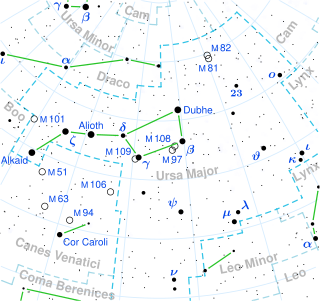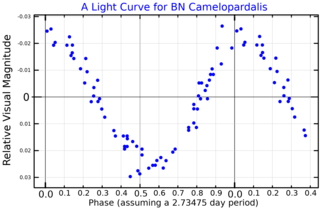Related Research Articles

Saul Perlmutter is a U.S. astrophysicist, a professor of physics at the University of California, Berkeley, where he holds the Franklin W. and Karen Weber Dabby Chair, and head of the International Supernova Cosmology Project at the Lawrence Berkeley National Laboratory. He is a member of both the American Academy of Arts & Sciences and the American Philosophical Society, and was elected a Fellow of the American Association for the Advancement of Science in 2003. He is also a member of the National Academy of Sciences. Perlmutter shared the 2006 Shaw Prize in Astronomy, the 2011 Nobel Prize in Physics, and the 2015 Breakthrough Prize in Fundamental Physics with Brian P. Schmidt and Adam Riess for providing evidence that the expansion of the universe is accelerating. Since 2021, he has been a member of the President’s Council of Advisors on Science and Technology (PCAST).

Omega Ursae Majoris is the Bayer designation for a binary star system in the northern circumpolar constellation of Ursa Major. It is visible to the naked eye with an apparent visual magnitude of 4.61. Based upon an annual parallax shift of 13.24 mas, it is roughly 246 light years from the Sun. At that distance, the visual magnitude of the star is diminished by an extinction factor of 0.11 due to interstellar dust.

Theta Virginis is a multiple star system in the zodiac constellation of Virgo. Based upon parallax measurements, it is about 320 light years from the Sun. The three stars in this system have a combined apparent visual magnitude of 4.37, bright enough to be seen with the naked eye.
109 Virginis is a single, white-hued star in the zodiac constellation of Virgo, located some 134.5 light years away from the Sun. It is the seventh-brightest member of this constellation, having an apparent visual magnitude of +3.72.

13 Andromedae, abbreviated 13 And, is a single, blue-white hued variable star in the northern constellation of Andromeda. 13 Andromedae is the Flamsteed designation, while it bears the variable star designation V388 Andromedae. With a typical apparent visual magnitude of around 5.75, it is dimly visible to the naked eye under good seeing conditions. The distance to this star can be directly estimated from its annual parallax shift of 10.9 mas, yielding a range of 300 light years. At that distance, its brightness is diminished by an extinction of 0.13 magnitude due to interstellar dust. The star is moving closer to the Earth with a heliocentric radial velocity of −8 km/s.

108 Aquarii is a star in the equatorial constellation of Aquarius. 108 Aquarii is the Flamsteed designation, although it also bears the Bayer designation i3 Aquarii and the variable star designation ET Aquarii. It has an apparent visual magnitude of 5.194 and can be seen with the naked eye under suitably dark skies. Based upon an annual parallax shift of 10.23, the distance to this star is 319 light-years.
5 Aquarii is a single star in the zodiac constellation of Aquarius, located about 830 light years away from the Sun, based on parallax. 5 Aquarii is the Flamsteed designation. It is visible to the naked eye as a faint, blue-white hued star with an apparent visual magnitude of 5.55. This object is moving closer to the Earth with a heliocentric radial velocity of −3 km/s.
Tau Cancri is a solitary, yellow-hued star in the zodiac constellation of Cancer. With an apparent visual magnitude of +5.42, it is faintly visible to the naked eye. Based upon an annual parallax shift of 11.92 mas as seen from Earth, it is located around 274 light-years from the Sun.
Jay Myron Pasachoff was an American astronomer. Pasachoff was Field Memorial Professor of Astronomy at Williams College and the author of textbooks and tradebooks in astronomy, physics, mathematics, and other sciences.

Adam Guy Riess is an American astrophysicist and Bloomberg Distinguished Professor at Johns Hopkins University and the Space Telescope Science Institute. He is known for his research in using supernovae as cosmological probes. Riess shared both the 2006 Shaw Prize in Astronomy and the 2011 Nobel Prize in Physics with Saul Perlmutter and Brian P. Schmidt for providing evidence that the expansion of the universe is accelerating.

Brian Paul Schmidt is a Distinguished Professor and astrophysicist at the University's Mount Stromlo Observatory and Research School of Astronomy and Astrophysics. He was the Vice-Chancellor of the Australian National University (ANU) from January 2016 to January 2024. He is known for his research in using supernovae as cosmological probes. He currently holds an Australian Research Council Federation Fellowship and was elected a Fellow of the Royal Society (FRS) in 2012. Schmidt shared both the 2006 Shaw Prize in Astronomy and the 2011 Nobel Prize in Physics with Saul Perlmutter and Adam Riess for providing evidence that the expansion of the universe is accelerating, making him the only Montana-born Nobel laureate. He was previously an Australian Research Council Laureate Fellow.

ET Andromedae is a binary star system star in the northern constellation of Andromeda. It has an apparent visual magnitude of 6.48, placing it at the nominal limit for visibility with the naked eye. The distance to this system can be estimated from its annual parallax shift of 5.42 mas, which yields a value of 602 light years.

DV Aquarii is a binary star system in the zodiac constellation of Aquarius. It has a peak apparent visual magnitude of 5.89, which is bright enough to be visible to the naked eye. The distance can be estimated from its annual parallax shift of 11.2 mas, yielding a separation of 291 light years.

BX Boötis is a star in the northern constellation of Boötes. It is a dim star near the lower limit of visibility to the naked eye, having a nominal apparent visual magnitude of 6.35. Based upon an annual parallax shift of 10.81 mas, it is located 302 light years away. At that distance, the visual magnitude of the star is diminished by an extinction of 0.13 due to interstellar dust. It is moving closer with a heliocentric radial velocity of −11 km/s.

BN Camelopardalis is a suspected astrometric binary in the northern circumpolar constellation of Camelopardalis. It appears as a variable star that is visible to the naked eye as a dim, white-hued point of light with an apparent visual magnitude that fluctuates around 5.49. The system is located at a distance of around 310 light years from the Sun based on parallax, and is drifting further away with a radial velocity of +9 km/s.

William Henry Press is an astrophysicist, theoretical physicist, computer scientist, and computational biologist. He is a member of the U.S. National Academy of Sciences, the American Academy of Arts and Sciences, and the Council on Foreign Relations. In 1989, he was elected a Fellow of the American Physical Society "in recognition of important theoretical contributions to relativistic astrophysics and to cosmology" Other honors include the 1981 Helen B. Warner Prize for Astronomy. Press has been a member of the JASON defense advisory group since 1977 and is a past chair.
Pi Draconis, Latinized from π Draconis, is a solitary star in the northern circumpolar constellation of Draco. It is visible to the naked eye with an apparent visual magnitude of 4.59. Based upon an annual parallax shift of 14.25 mas as measured from Earth, it is located around 229 light years from the Sun. At that distance, the visual magnitude is diminished by an extinction factor of 0.063±0.10 due to interstellar dust.
22 Cygni is a binary star system in the northern constellation of Cygnus. It is visible to the naked eye as a faint, blue-white hued star with an apparent visual magnitude of 4.95. The annual shift of 3.0 mas yields a distance estimate of around 1,070 light years. It is moving closer to the Earth with a heliocentric radial velocity of −15 km/s.

104 Herculis is a solitary variable star located around 560 light years away from the Sun in the northern constellation of Hercules. It has the variable star designation V669 Herculis and the Bayer designation A Herculis, while 104 Herculis is the Flamsteed designation. This object is visible to the naked eye as a dim, red-hued point of light with a baseline apparent visual magnitude of 4.96. It is moving closer to the Earth with a heliocentric radial velocity of −1.2 km/s.

13 Monocerotis is a class A0 Ib star in the constellation Monoceros. Its apparent magnitude is 4.5 and it is approximately 780 parsecs (2,500 ly) away.
References
- ↑ "Saul Adelman CV" (PDF). Retrieved 2 April 2009.
- ↑ "Saul Adelman" . Retrieved 2 April 2009.
- ↑ "A study of twenty-one sharp-lined non-variable cool peculiar A stars" . Retrieved 2 April 2009.
- ↑ "Adelman, S on NASA ADS Author Search" . Retrieved 17 April 2009.